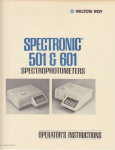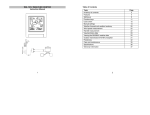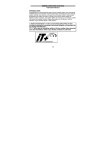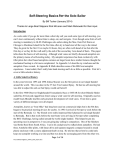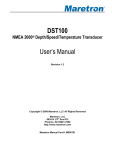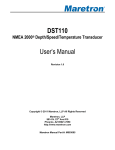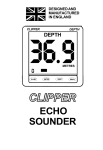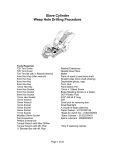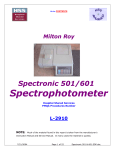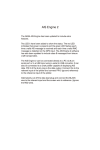Download Target Log/Depth/Wind
Transcript
INSTALLATION AND USER INSTRUCTIONS for TARGET 2 LOG, DEPTH & WIND MARINE INSTRUMENTS NASA MARINE LTD BOULTON ROAD STEVENAGE HERTS. SG1 4QG (01438) 354033 page 12 Page 1 LIMITED WARRANTY 1: INTRODUCTION Nasa Marine Ltd. warrants this instrument to be substantially free of defects in both materials and workmanship for a period of one year from the date of purchase. Nasa Marine Ltd. will, at its discretion, repair or replace any components which fail in normal use within the warranty period. Such repairs or replacements will be made at no charge to the customer for parts and labour. The customer is however responsible for transport costs. This warranty excludes failures resulting from abuse, misuse, accident, or unauthorised modifications or repairs. In no event shall Nasa Marine Ltd. be liable for incidental, special, indirect or consequential damages, whether resulting from the use, misuse, the inability to correctly use the instrument, or from defects in the instrument. If any of the above terms are unacceptable to you then return the instrument unopened and unused to your retailer for full credit. Target instruments are designed to operate from a 12 volt battery supply and are supplied complete with sensors, displays and display mounting kits. Prior to unpacking this instrument read and fully understand the installation instructions. Only proceed with the installation if you are competent to do so. Nasa Marine Ltd. will not accept any responsibility for injury or damage caused by, during or as a result of the installation of this product. Any piece of equipment can fail due to a number of causes. Do not install this equipment if it is the only source of information and its failure could result in injury or death. Instead return the instrument to your retailer for full credit. Remember this equipment is an aid to navigation and not a substitute for proper seamanship. This instrument is used at your own risk, use it prudently and check its operation from time to time against other data. Inspect the installation from time to time and seek advice if any part thereof is not fully seaworthy. To keep your instruments looking good clean only with a damp cloth. Do not use Abrasive cleaners or solvents. 2: INSTALLING THE DISPLAY Target instruments are waterproof when panel mounted and are designed for open cockpit mounting. Select a convenient position for the display on a panel or bulk head. The site must be flat and the cavity behind the panel must remain dry at all times. (The cable entry boss is not sealed to allow free passage of air to and from the unit. This prevents misting of the display.) The positions for the fixing holes can be marked on the panel using the drill template which is an integral part of the packing carton. Before drilling check that there is sufficient space behind the panel to route the cables and to allow access to tighten up the wing fixing nuts. Drill the five holes and check that the unit fits. It may be wise to connect the cables before finally fixing the unit in position. A sponge rubber seal is provided which should be fitted into the slot in the back of the instrument. Fit the instrument into the panel and tighten the four wing nuts finger tight only. It is important that the sponge rubber seal makes good contact with the panel or water may get behind the unit and enter the cavity behind the panel. It is always good practice to take the cables vertically down from the unit. page 10 Page 3 3: ECHO SOUNDER 5: WIND 3:1 INSTALLING THE TRANSDUCER 5::1 PRE-TEST OF INSTRUMENT The transducer can be mounted in one of three ways: (a) The transducer face can be bonded directly to the inside of the hull. (Some energy is lost to the hull but the loss in performance is, for most G.R.P, hulls, hardly noticeable). (b) A transom mount is available from your dealer. (c) The transducer can be positioned inside a GRP hull by means of an In Hull Transducer kit. This method of installation has the dual advantage that no hole is made in the vessels hull and that the echo sounder and transducer can easily be removed for examination or installation elsewhere. It should be mentioned however, that although the accuracy will in no way be affected by installing the transducer inside the hull, the maximum range sensitivity may be reduced, depending on the thickness and quality of the glass fibre. The In Hull Kit is available direct from NASA Marine or your local chandler. Whichever is selected the best location still has to be found. Select a position below the water level where the transducer will point substantially towards the sea bed and where the transducer and cable are kept well clear of interference generating equipment. This position should be well clear of large masses of bubbles or cavitation which would disrupt the signal. To test the suitability of the location, press a little sticky chewing gum on the surface of the transducer and stick it down to the inside of the hull (remove dirt and oily residue first). The unit can then be tested. If the location is satisfactory the chewing gum can be removed and the transducer mounted using one of the methods described previously. (Note: Do NOT shorten the transducer cable). It is important that the face of the transducer is thoroughly bonded down to the hull. A single air bubble will cause a considerable loss in performance. The transducer and the place of mounting must be kept entirely free of any antifouling compound as this can also effect the performance of the unit. Before mounting check that the instrument is complete and undamaged. Plug the sensor into the display unit and apply 12 volts. Gently spin the wind cups and the wind vane and check the operation of the display. 5::2 INSTALLING THE MASTHEAD UNIT The masthead sensor unit is designed for mast mounting and is supplied with 20 metres of cable. Choose a position where the masthead unit can receive an unobstructed flow of air from all directions. The masthead unit must be substantially horizontal, however the orientation with respect to the boat is unimportant. Four mounting blocks together with four stainless steel self tapping screws are supplied to screw the masthead unit to a metal mast. If the masthead unit is to be fitted to a wooden mast suitable screws should be used. After the masthead unit is securely fitted run the cable to the display unit and plug into the socket on the display. Do not reduce any excess length of the cable by cutting off the plug, but stow the excess neatly. If the cable is not long enough, 5 or 20 metre extension cables are available. 5::3 CONNECTING THE DISPLAY Connect the black wire to the negative supply and the red to the positive via a 250 milli-amp fuse. Plug the masthead unit into the socket on the display unit. 5::4 WIND OPERATION The Target wind system can display wind speed measurements in miles per hour (MPH), nautical miles per hour (knots, shown as KTS), and metres per second (m/s). Press ENTER and up together to switch between knots, miles per hour, and meters per second. The choice is always saved so the unit operates as set whenever it is powered up again. WINDVANE DEAD-AHEAD ALIGNMENT It is always necessary to enter the dead-ahead position of the vane when it is first installed on the vessel so the display shows the relative wind direction correctly. Setting the dead-ahead alignment is achieved by pressing all three buttons together when the vane is aligned with the stainless steel tip pointing forward along the axis of the vessel. The reading is stored when the last button is released, and so it is important that the vane is correctly aligned at that moment. CHANGING THE POINTER STYLE The pointer style can be either a block or ‘Windex’ style. Press up and down together to switch between the styles. When the block pointer is displayed, up increases its width and down decreases its width. The up and down keys have no effect when the ‘Windex’ pointer style is displayed. As with the speed setting, the final setting is stored so the unit operates as set when ever it is powered up again. Backlight The backlight is switched by pressing ENTER alone. Page 9 page 4 4:2 CONNECTING THE DISPLAY Connect the black wire to the negative supply and the red wire to the positive via a 250 milli-amp fuse. Plug the paddle wheel unit into the socket on the display unit. 4:3 LOG OPERATION When switched on the display will momentarily display the total distance and then revert to reading speed. The speed is shown in nautical miles per hour and is reliable up to 25.0 knots. (At higher speeds cavitation around the paddlewheel may reduce accuracy.) 3:2 NOTES ON ELECTRICAL INTERFACE External electrical interference is characterised by persistent, random numbers on the display which obscure the true depth reading on the depth sounder. This is caused by large amplitude voltage "spikes" generally associated with the engine's alternator and/or ignition system which has not been properly suppressed. These "spikes" may find their way into the sensitive amplifier section of the depth sounder in two ways: (a) Through the craft's common power supply or (b) Through direct radiation from the source of interference. A short press of the SPEED key will turn the backlight on and off. A short press of the TRIP key will display the Trip distance. To reset the trip to Zero, first select trip by pressing the TRIP key. When the trip distance is shown press and hold the TRIP key until the display shows ' F '. The trip is then reset to Zero. The trip distance is shown in tenths of nautical miles up to 99.9nm and in single miles up to 999nm thereafter. To reduce the possibility of induced interference from the engine's generator and/or ignition system choose a position as far away from the engine as possible and run the cable from the transducer as far as practicable from the engine. Do NOT cut the transducer cable, but stow excess away from any possible source of electrical interference. 3:3 CONNECTING THE DISPLAY A short press of the TOTAL key will display the total distance. The unit will display the total distance travelled to 999 nautical miles. This counter cannot be reset. A long press of the SPEED key will return to the Speed display CALIBRATION The calibration is preset in the factory. The type of hull and the position of the paddlewheel may affect the performance of the unit. If the log under or over reads then the calibration factor can be adjusted to compensate. Enter the Engineering mode by first turning off the power supply to the instrument. Press and hold the SPEED key whilst the power supply is turned back on. The word ENG will appear on the display. Press either the TRIP or TOTAL keys to display the calibration setting. This is normally 100 (%) when it leaves the factory. Press TRIP to increase or TOTAL to decrease the number. Each press will increment or decrement the number by 1%. When the desired calibration factor is attained a long press of the SPEED key will return the unit to normal operation. Both speed and distance are calibrated simultaneously. The calibration factor is stored in a non-volatile memory and is retained when power is off. page 8 Connect the black wire to the negative supply and the red wire to the positive via a 250 milli-amp fuse. The red wire of the alarm is also connected to the positive supply whilst the black wire connects to the green wire from the display unit. The alarm is not watertight and must be mounted in a protected position. Plug the transducer into the socket on the display unit. 3:4 SOUNDER OPERATION Various operational parameters need to be set into the memory prior to use to get the best from your Target depth sounder. Once set, these parameters are permanent and are not likely to require adjustment. Most depth sounders measure the depth below the transducer. It is often more convenient to display the depth below the keel. A facility has been included where the vertical distance between the transducer face and the bottom of the keel (the keel offset) can be programmed into the unit. The unit then reads the true depth below the keel. (On delivery the keel offset is zero so the unit will read the depth below transducer). BACK LIGHT: A quick press of the SET key will turn on the back light. A further quick press of the SET key will turn the back light off. Page 5 TO SET THE KEEL OFFSET Put the unit into engineering mode. (This is achieved by turning off the power supply to the unit and turning the power back on whilst the SET key is depressed). The word ‘ENG’ will appear until the SET key is Released. Now use The up and down keys to enter the required keel offset. A long press on the SET key will return to normal echo sounder operation. 4: LOG 4:1 INSTALLING THE PADDLEWHEEL UNIT The paddle wheel should be installed at a point in the hull where:1) It is immersed at all attitudes under power or sail. SELECTING THE OPERATING UNITS (FEET or METRES) Put the unit into engineering mode (see above). A short press on the SET key will swap the units from feet to metres. A long press on the SET key will return to normal echo sounder operation. SETTING THE SENSITIVITY THRESHOLD Echoes received from near objects will clearly be larger than from more distant objects. Echoes from keels or turbulence under the boat may be substantially greater than echoes from the sea-bed and may cause the sounder to alternate between the sea-bed and something more local. To overcome this problem, the Target sounder is fitted with variable swept gain. This reduces the sensitivity for local objects, progressively increasing the sensitivity as depth increases The point at which the gain starts to rise is called the sensitivity threshold. The sensitivity of the unit at depths below the sensitivity threshold will be considerably reduced whilst above the sensitivity threshold the unit rapidly becomes more sensitive with increasing depth. The sensitivity threshold is factory set to 0.0 metres. To view the sensitivity and down threshold press SET The value can be altered by using the up keys. The value is then fixed in memory by pressing SET. USING THE ALARMS The alarm will sound if an echo is received which is shallower than the upper alarm setting or deeper than the lower alarm setting. To view the setting of the upper (Shallow) alarm, press the up key. Return to sounder by pressing SET. To view the setting of the lower (Deep) alarm, press the down key. The setting can be altered by using the up and down keys. The new value is entered and the unit returned to the echo sounder by pressing the SET key. To enable the alarm, press the up and down keys simultaneously. A ‘Bell’ symbol will appear to show the alarm is activated. When an alarm condition is apparent the bell symbol will flash and the audible alarm will sound. Pressing up and down keys again will disable the alarm. All parameters set into the unit are held in memory even when the power is removed. page 6 2) The blades of the paddle wheel are presented with a smooth flow of water corresponding to the vessels speed through the water. On displacement hulls this is usually about amidships , but on planing hulls it should be as far aft as possible. 3) It should be easily accessible in the bilges for cleaning and laying up. A blanking cap is provided to seal the skin fitting when the paddle wheel is removed. 4) It is not vulnerable to damage from unforgiving surfaces such as trailers and lifting slings. Drill a hole of 42mm diameter to take the skin fitting and use conventional methods for sealing. It is advisable to avoid the use of mastic materials - use a form of proprietary silicon sealant. The securing nut has a groove on its underside which should also be filled with sealing compound. Finger tighten this nut only. After the sealing compound has set wipe off the excess and encapsulate the whole assembly in G.R.P. as shown in the diagram. Take care to ensure that a minimum of 20mm of thread is left uncovered. The paddle wheel unit can now be slid into the housing, with the arrow pointing along the centre line of the vessel. It is recommended that a little silicon grease be smeared over the rubber "O" ring to keep the unit free. 20mm minimum HULL Page 7





